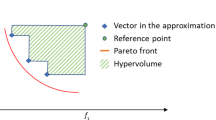Abstract
The NSGA-II algorithm uses a single population single crossover operator, which limits the search performance of the algorithm to a certain extent. This paper presents an improved version of the NSGA-II algorithm, named adaptive multi-population NSGA-II (AMP-NSGA-II) that divides the original population into multiple populations and assigns a different crossover operator to each subspecies. It introduces an excellent set of solutions (EXS), which can make the individuals in the EXS set close to the Pareto front and improve the convergence performance of the algorithm. And based on the analysis of the EXS set, the size of each subpopulation can be dynamically adjusted, which can improve the adaptability for different problems. Finally, the computation results on benchmark multi-objective problems show that the proposed AMP-NSGA-II algorithm is effective and is competitive to some state-of-the-art multi-objective evolutionary algorithms in the literatureis.






Similar content being viewed by others
Explore related subjects
Discover the latest articles, news and stories from top researchers in related subjects.References
Cai Y, Wang J (2015) Differential evolution with hybrid linkage crossover. Inf Sci 320:244–287
Deb K, Anand A, Joshi D (2002a) A computationally efficient evolutionary algorithm for real-parameter optimization. Evol Comput 10(4):371–395
Deb K, Pratap A, Agarwal S, Meyarivan T (2002b) A fast and elitist multiobjective genetic algorithm: NSGA-II. IEEE Trans Evol Comput 6(2):182–197
Deb K, Thiele L, Laumanns M, Zitzler E (2005) Scalable test problems for evolutionary multiobjective optimization. In: Abraham A, Jain L, Goldberg R (eds) Evolutionary multiobjective optimization. Advanced information and knowledge processing. Springer, London, pp 105–145. https://doi.org/10.1007/1-84628-137-76 https://doi.org/10.1007/1-84628-137-76
Eshelman LJ, Schaffer JD (1993) Real-coded genetic algorithms and interval-schemata. In: Foundations of genetic algorithms, vol 2. Elsevier, pp 187–202
Lee KB, Kim JH (2014) DMOPSO: Dual multi-objective particle swarm optimization. In: 2014 IEEE Congress on Evolutionary Computation (CEC). IEEE, pp 3096–3102
Li AD, He Z, Zhang Y (2016) Bi-objective variable selection for key quality characteristics selection based on a modified NSGA-II and the ideal point method. Comput Ind 82:95–103
Nebro AJ, Luna F, Alba E, Dorronsoro B, Durillo JJ, Beham A (2008) AbYSS: Adapting scatter search to multiobjective optimization. IEEE Trans Evol Comput 12(4):439–457
Nebro AJ, Durillo JJ, Garcia-Nieto J, Coello CC, Luna F, Alba E (2009) SMPSO: A new pso-based metaheuristic for multi-objective optimization. In: 2009. mcdm’09. ieee symposium on Computational intelligence in miulti-criteria decision-making. IEEE, pp 66–73
Pourvaziri H, Naderi B (2014) A hybrid multi-population genetic algorithm for the dynamic facility layout problem. Appl Soft Comput 24:457–469
Qiao S, Dai X, Liu Z, Huang J, Zhu G (2012) Improving the optimization performance of NSGA-II algorithm by experiment design methods. In: 2012 IEEE International Conference on Computational intelligence for measurement systems and applications (CIMSA). IEEE, pp 82–85
Saborido R, Ruiz AB, Luque M (2017) Global WASF-GA: an evolutionary algorithm in multiobjective optimization to approximate the whole pareto optimal front. Evol Comput 25(2):309–349
Toledo CFM, Franċa P M, Morabito R, Kimms A (2009) Multi-population genetic algorithm to solve the synchronized and integrated two-level lot sizing and scheduling problem. Int J Prod Res 47(11):3097–3119
Tran KD (2009) An improved non-dominated sorting genetic algorithm-ii (ANSGA-II) with adaptable parameters. Int J Intell Syst Technol Appl 7(4):347–369
Tsutsui S, Yamamura M, Higuchi T (1999) Multi-parent recombination with simplex crossover in real coded genetic algorithms. In: Proceedings of the 1st Annual Conference on Genetic and Evolutionary Computation. Morgan Kaufmann Publishers Inc., vol 1, pp 657–664
Yijie S, Gongzhang S (2008) Improved NSGA-II multi-objective genetic algorithm based on hybridization-encouraged mechanism. Chin J Aeronaut 21(6):540–549
Zhong YB, Xiang Y, Liu HL (2014) A multi-objective artificial bee colony algorithm based on division of the searching space. Appl Intell 41(4):987–1011
Zhou A, Qu BY, Li H, Zhao SZ, Suganthan PN, Zhang Q (2011) Multiobjective evolutionary algorithms: a survey of the state of the art. Swarm Evol Comput 1(1):32–49
Zitzler E, Deb K, Thiele L (2000) Comparison of multiobjective evolutionary algorithms: Empirical results. Evol Comput 8(2):173–195
Author information
Authors and Affiliations
Corresponding author
Rights and permissions
About this article
Cite this article
Zhao, Z., Liu, B., Zhang, C. et al. An improved adaptive NSGA-II with multi-population algorithm. Appl Intell 49, 569–580 (2019). https://doi.org/10.1007/s10489-018-1263-6
Published:
Issue Date:
DOI: https://doi.org/10.1007/s10489-018-1263-6




